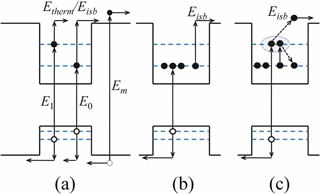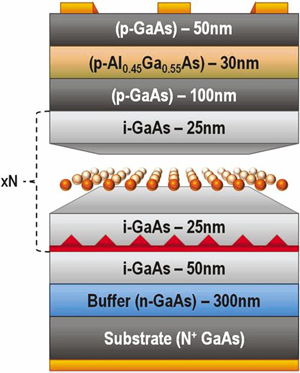- News
26 May 2011
Built-in charge boosts quantum dot solar cell efficiency
Researchers at US military and academic institutions have improve quantum dot (QD) solar cell performance by as much as 50% through doping [Kimberly A. Sablon et al, Nano Lett., published online 5 May 2011].
 Up to now, QD solar cells have had disappointing performance, compared with predictions of efficiency increases of 64% through increasing the numbers of energy levels (Figure 1). The hope has been to increase the amount of light absorption and to extend the absorption edge into the infrared range. Instead, there tends to be a trade-off between modest increases in short-circuit current density (JSC) offset against deterioration in open-circuit voltage (VOC).
Up to now, QD solar cells have had disappointing performance, compared with predictions of efficiency increases of 64% through increasing the numbers of energy levels (Figure 1). The hope has been to increase the amount of light absorption and to extend the absorption edge into the infrared range. Instead, there tends to be a trade-off between modest increases in short-circuit current density (JSC) offset against deterioration in open-circuit voltage (VOC).
Figure 1: (a) Photogeneration of electron–hole pairs into the ground QD state (E0) and into the excited QD state (E1) followed by either thermionic emission (Etherm) or intersubband photoexcitation (Eisb) into the conducting channel; Em is the direct photogeneration in the GaAs matrix. (b) Process induced by n-doping with IR transition of an electron from the localized to the conducting state. (c) Another doping-induced process, where the radiation excites two electrons to QD excited states, then — due to strong inter-electron interaction in a QD — one of these electrons transfers to the conducting state and the other transfers to a low-energy state.
One potential problem from increasing the number of energy levels is increased recombination of carriers before they can be extracted from the photovoltaic structure, analogous to the Shockley–Read–Hall (SRH) recombination that occurs from deep impurity levels.
The research team from US Army Research Laboratory, University at Buffalo, and US Air Force Office of Scientific Research Physics and Electronics directorate (AFOSR/NE) set out to investigate the possibility of using doping to improve QD solar cell performance by adding charge to the dots. Such doping has been found to avoid deterioration of VOC in normal heterojunction solar cells (i.e. without dots). In addition to the voltage improvement, the researchers also expected that doping-induced light absorption processes would aid energy harvesting and the extension of infrared response (Figure 1b, c).
 Figure 2 (right): Growth diagram of delta-doped QD solar cell structure.
Figure 2 (right): Growth diagram of delta-doped QD solar cell structure.
In particular, the researchers expected improvements from adding electrons to the dots: “The energy-level spacing for electrons in QDs is relatively large. It substantially exceeds the spacing for holes and the thermal energy. For this reason, it is precisely the electron intradot processes that limit the electron–hole escape from QDs. Thus, it is critically important to enhance the photoexcitation of electrons rather than holes.”
The material structure of their quantum dots with built-in charge (Q-BIC) solar cell (Figure 1) was created using molecular beam epitaxy (MBE) on heavily doped n-type gallium arsenide substrates. The n-type buffer layer was grown at 595°C, while the quantum dot layers were grown at the lower temperature of 530°C.
Quantum dots were stacked in 20 layers consisting of 2.1 monolayers of indium arsenide (InAs) separated by 50nm gallium arsenide spacers. The effect of putting a very thin layer of InAs in GaAs is for phase separation to occur, resulting in self-assembled InAs quantum dots.
The distance between the layers was made relatively large in order to dissipate strain and hence suppress dislocations. In addition, the large spacing reduces tunneling and prevents formation of an intermediate band.
Delta doping between the layers was used to provide electrons to occupy the quantum dots with up to six electrons on average. (Delta doping with p-type material, adding holes to the quantum dots instead, was found to reduce conversion efficiency, as expected.) The structure was completed with three p-doped layers.
The epitaxial material was used to create circular solar cells of 250μm diameter. The n-type contact consisted of annealed tin-gold-tin evaporated on to the back side of the substrate. A ring p-type contact was used with 100μm opening, consisting of chromium-gold. The devices were mounted in 68-pin leaded chip carrier (LDCC) packages using indium.
The researchers report on their measurements (Table 1): “For the most heavily doped sample, the photovoltaic efficiency improves by as much as 50% compared with an undoped device. Because we have not observed any evidence of the effect saturating, we can expect an even stronger enhancement of the photovoltaic efficiency for further increase of the doping level.”
Average dot electron population |
JSC (mA/cm2) |
VOC (V) |
Fill factor (%) |
Efficiency (%) |
0 |
15.1 |
0.77 |
77 |
9.31 |
2 |
17.3 |
0.74 |
76 |
9.73 |
3 |
18.5 |
0.79 |
75 |
12.1 |
6 |
24.3 |
0.78 |
72 |
14.0 |
Table 1: QD solar cell parameters under 1 sun (AM1.5 G) at 100mW/cm2 illumination for QD solar cells as a function of doping designed to provide 0, 2, 3, and 6 electrons per dot on average.
However, “One of the limitations on the doping level may originate due to Auger recombination, which at the current doping levels remains substantially weaker than the Shockley–Read–Hall recombination.” Auger recombination only occurs when there are large numbers of carriers present.
Spectral investigations showed that one effect of delta-doping quantum dots is to increase the response to longer-wavelength photons (880–1150nm), at the expense of short wavelengths (less than 880nm). The researchers associated the response above 920nm with QD excited and ground states. Beyond this, one also finds a rise in the region 4.8μm (4800nm) that the team attributes to a transition from the dot ground state to the low-energy resonance conducting state (Eisb in Figure 1b). A broad weak peak is also seen above this up to ~8.0μm, where the experimental measurements are close to the edge of their capability. The strength of the peak depends on the amount of delta doping and is completely absent in undoped GaAs reference samples (i.e. without QDs).
The researchers also believe that their structure could benefit from pumping effects, where the energy harvesting takes place in a number of steps: “The improvement of IR harvesting is anticipated to be even stronger at higher radiation intensities due to optical pumping effects. This makes the Q-BIC solar cells promising candidates for use with concentrators of solar radiation.”
Quantum dot solar cells GaAs AlGaAs InAs MBE
The author Mike Cooke is a freelance technology journalist who has worked in the semiconductor and advanced technology sectors since 1997.
